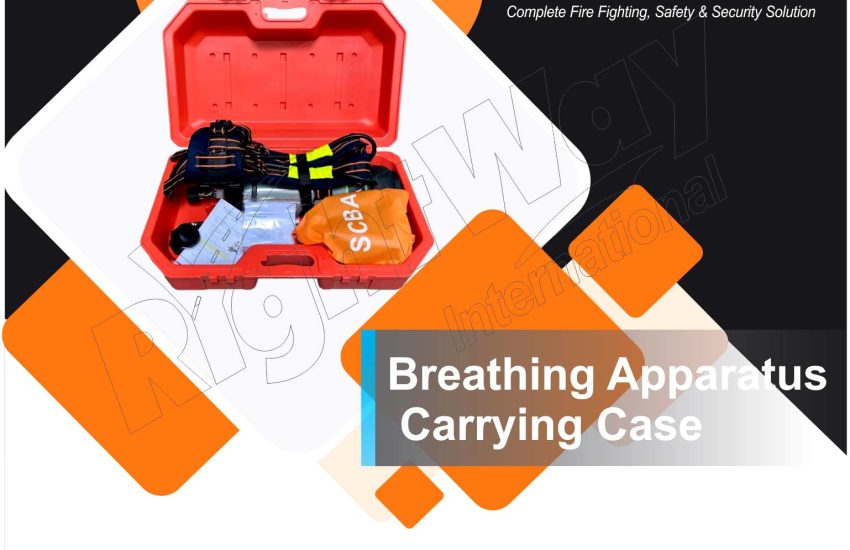Breathing Apparatus Carrying Case is a specialized container designed to protect, transport, and store respiratory protection equipment, such as Self-Contained Breathing Apparatus (SCBA) and related gear. These cases are vital for ensuring that such life-saving equipment remains in optimal condition and is readily accessible when needed.
1. Purpose and Importance
The carrying case serves several key functions:
- Protection: It shields the breathing apparatus from physical damage, dust, moisture, and environmental contaminants.
- Organization: It keeps all components of the system organized and easily accessible.
- Transport: It enables safe and convenient transport of equipment across locations.
- Storage: It provides a secure and designated space for storage, helping to extend the equipment’s lifespan.
2. Components of a Breathing Apparatus Carrying Case
Each case is carefully designed with multiple critical components:
Case Body
- Constructed from durable materials like high-density polyethylene (HDPE), polypropylene, or metal alloys.
- Built to withstand harsh conditions and repeated handling.
Padding
- Includes internal foam inserts or padding to cushion the breathing apparatus.
- Helps prevent movement and minimizes damage during transit.
Compartments
- Contains dedicated sections or pockets for components such as:
- Air cylinders
- Facepieces
- Regulators
- Harnesses
Closure Mechanisms
- Zippers: Heavy-duty zippers, often used in fabric cases with reinforced stitching.
- Latches: Locking or snap latches used in hard cases for enhanced security.
Handles and Straps
- Features ergonomic handles or adjustable shoulder straps for ease of transport.
Ventilation
- Some models include ventilation ports to promote air circulation, reducing moisture buildup.
Identification Labels
- Areas designed for labeling and safety instructions, aiding easy identification during emergencies.
3. Types of Breathing Apparatus Carrying Cases
Different types of cases serve various operational needs:
- Hard Cases: Rigid and extremely durable, ideal for high-impact environments.
- Soft Cases: Lightweight and flexible, suitable for easy transport and handling.
- Customized Cases: Designed to fit specific apparatus models, offering optimal organization and protection.
- Waterproof Cases: Built to resist water ingress, making them suitable for wet or harsh environments.
4. Applications
Breathing apparatus carrying cases are used in several fields, including:
- Firefighting: For transporting SCBA units to and from emergency scenes.
- Industrial Safety: Used in environments such as chemical plants and factories.
- Emergency Services: Essential for EMS and disaster response teams.
- Confined Spaces: Commonly used in operations where workers enter hazardous or restricted areas.
5. Maintenance and Care
Proper upkeep is essential for the case’s performance and longevity:
- Regular Inspections: Look for signs of wear, contamination, or damage.
- Cleaning: Follow manufacturer guidelines. Use mild detergents for fabric and damp cloths for hard cases.
- Storage: Store in cool, dry environments, away from direct sunlight or extreme temperatures.
- Repairs and Replacement: Address any defects promptly, and replace when necessary to maintain equipment safety.
6. Safety Considerations
To ensure safe and effective use:
- Proper Use: Only use the case for its intended purpose.
- Secure Fastening: Ensure zippers or latches are closed properly to avoid contamination or equipment loss.
- Training: Provide adequate training on handling and maintenance, especially for first responders or industrial workers.
7. Regulatory Compliance
For full reliability and safety, cases must comply with recognized standards:
- OSHA (Occupational Safety and Health Administration)
- NIOSH (National Institute for Occupational Safety and Health)
- CEN (European Committee for Standardization)
- ANSI (American National Standards Institute)
Conclusion
In summary, a Breathing Apparatus Carrying Case plays a crucial role in protecting, organizing, and transporting life-saving respiratory equipment. By understanding its features, types, and care requirements, users can ensure that the equipment remains ready for deployment at all times. Ultimately, regular maintenance, proper training, and adherence to regulatory standards are key to maximizing the case’s lifespan and effectiveness.


